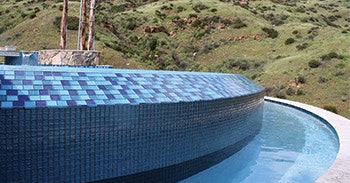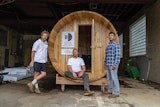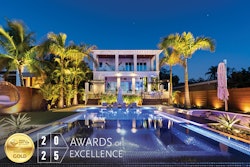 An adequately sized catch basin – one that has enough volume to accept water-in-transit, bather surcharge and accommodate the possible effects of wind – is critical to ensure proper hydraulic function.
An adequately sized catch basin – one that has enough volume to accept water-in-transit, bather surcharge and accommodate the possible effects of wind – is critical to ensure proper hydraulic function.
Throughout my many years of expert witness work for the California State Contractors License Board and other capacities where I've seen project defects firsthand, I've been dismayed by some of the serious, yet avoidable mistakes that keep cropping up. An area I see some of the more egregious errors is the ubiquitous vanishing edge.
As we all should know by now, these pools have become a mainstay of custom design and construction. Once considered exotic and even futuristic, vanishing edge pools (or infinity pools as some call them) are now one of the most common design elements at our disposal.
Based on their popularity, we might be tempted to think correctly designing and building pools with vanishing edges should be automatic, or close to it. Sadly, based on my experience, that is far from the case. Failures and defects remain too common, and let's face it, a project that doesn't function properly is bad for everyone involved, from the homeowner to the contractor and the industry at large.
The good news is that mastering the vanishing is, or at least should be, well within the reach of most competent builders. There's a lot to it, but as the old saying goes, it's not rocket science. To help zero in on the key issues, I thought it might be useful to create a list of the most common errors I see.
THE BIG POINTS
 Under-sizing the catch basin is one of the most common mistakes we see on pools with vanishing edges, one that can lead to flooding and all the expensive damage that goes with it.
Under-sizing the catch basin is one of the most common mistakes we see on pools with vanishing edges, one that can lead to flooding and all the expensive damage that goes with it.
Call it a pocket guide, primer, cheat sheet or whatever; the point is these items are all critical in establishing the difference between success and failure when working on a vanishing edge. The exact order of importance is debatable, and may even shift based on the situation, but if you don't get these points right, trouble is almost sure to follow.
Basin size and shape: Among the most common mistakes, and arguably the most serious, is a failure to design and build an adequately sized catch basin. There are differing formulas for calculating basin size, but the bottom line is the basin needs to be large enough to capture all the water flowing over the edge.
Within that requirement, we need to consider three basic factors: water-in-transit, bather surge and wind.
In the context of a vanishing edge pool, water-in-transit refers to the volume of water that is required to raise the upper pool high enough so it flows over and wets the entire edge. It also includes the volume of water that is actually spilling over the weir wall when the edge feature pump is in operation. Keep in mind, the farther the fall from the edge to the basin, the larger the volume of water that is, quite literally, in transit.
That means you have to have enough volume in the catch basin to accept all the water needed to make the edge work. It's a basic hydraulic calculation, but if you guess and come up short, the consequences can be dire.
I'm currently consulting on an expensive hillside project; it's all built on piles, and the vanishing edge basin is a foot wide by 18 inches deep. When you turn on the pump, the system sucks the basin dry before enough water can flow over the top. That's a major problem and the fix will be expensive.
After that, you have to have additional volume to accept the water that's displaced by bathers, referred to as "bather surge." Admittedly, this can be tough to calculate absent some approximate idea of how many people might be in the pool at any given time. We do know that a 155 lb. human body displaces about 18.5 gallons, so if you anticipate a maximum of 10 people, which is what I typically assume, the math is simple.
 The water's surface plays a key role in the aesthetics of vanishing edge designs. Textured water resulting from associated waterfeatures will disrupt the reflections, which may or may not be an issue with the homeowner. The key is to be sure you're on the same page with the client before installing elements that disturb the surface.
The water's surface plays a key role in the aesthetics of vanishing edge designs. Textured water resulting from associated waterfeatures will disrupt the reflections, which may or may not be an issue with the homeowner. The key is to be sure you're on the same page with the client before installing elements that disturb the surface.
Wind impacts basin design, but in a much different way. The basin needs be wide enough to catch the water flowing over the edge when it's windy. If the water is blown beyond the basin, you might erode the slope below the pool, which can lead to all sorts of serious problems. How wide the trough should be depends on the height of the drop and the anticipated velocity of the wind. It is important to know which direction the prevailing wind comes from and how it affects basin design.
Waterproofing the weir wall: Reducing water from migrating through the vanishing edge, or weir wall, is a critical part of any vanishing edge pool. I always recommend using a waterproofing agent that is suitable for "positive and negative" side waterproofing, meaning that the waterproofing product should be applied to both sides and the top of the freestanding vanishing edge wall. Many contractors opt for redundancy and use a subsurface crystalline waterproof product first and then apply a waterproof membrane.
Improper waterproofing will increase the risk that water will work its way through the wall, which can lead to surface delamination on the outside of the wall and/or damage from mineral buildup.
Water migration: This is a point that is often missed, but one that can have a significant potential impact. I've seen a number of projects where the water spills beyond the sides of the catch basin. If you don't take measures to keep the water going where it's meant to go, water falling outside the basin can damage the slope or undermine the pool structure.
The solution is to create small baffles or contours on the ends of the edge that direct the water into the basin.
Water auto-fill system for the pool: Vanishing edge pools typically require an automatic filling system to compensate for evaporation and splashout.
Auto-fill units should usually be installed on the lower level of the vanishing edge basin wall, not on the upper main pool. (The water level in the upper pool will remain full, so there's no need for an auto-fill in the upper pool. By contrast, the lower basin is where the water level changes — and it changes significantly. This is where you'll see the net result of evaporation and splash out.)
 Although commonplace these days, vanishing edge pools remain some of the most daring, complex and beautiful installations – especially for settings with beautiful vistas.
Although commonplace these days, vanishing edge pools remain some of the most daring, complex and beautiful installations – especially for settings with beautiful vistas.
In addition, some builders use inexpensive ball float valves on the lower basin instead of electronic leveling systems. Keep in mind that as soon as you turn on the pump, you're now evacuating the basin and returning the water into the pool. The basin drops equivalent to the amount of water in transit. That triggers the improperly placed float valve to continuously fill the basin while the pump is running. Later, when the pump is turned off, the water in transit drops into the lower basin and overtaxes the vessel. That in turn causes water to spill over the top of the basin or down the overflow.
An electronic water-leveling device has a high point and a low point. The high point activates the edge pump to keep water in transit when bather surcharge requires it. The low point is set at the optimal operation level. When the level drops, it triggers the water fill line in the upper vessel and balances the water volume.
Supporting Reflections: Another common mistake I see in vanishing edge pools is that the plumber places return lines so that they create ripples in the surface of the water, thus distorting the water's reflective quality.
Many clients select a vanishing edge pool because they want to have the surface look like a sheet of glass. The more still the water, the better the effect. That's why you should use in-floor returns with diverters to keep surface rippling at a minimum.
Catch Basin Tile: Because water levels fluctuate a lot in the lower basin, we usually tile down 18 inches, not just six inches, as is typical of most swimming pools. This wider band of tile will protect the plaster/pebble finishes, which really don't hold up well in alternating wet and dry conditions.
Separate Filtration and Edge-Effect Circulation: Use one variable speed pump and filter for the circulation of the upper pool with a skimmer at the water surface so debris flowing over the edge is kept to a minimum.
I recommend a second variable-speed pump and filter to handle the overflow on the vanishing edge. A variable-speed pump will enable you to keep the weir wall wet with the least amount of water possible, which in turn saves energy. Also, keeping the weir wall wet during daytime hours reduces the amount of mineral buildup you get on tile and stone.
Pest Control: This one is commonly missed in hillside installations. Keep in mind, gophers can tunnel up to 100 feet per day and can rapidly undermine hillside integrity. While this is a subject that isn't always easy to discuss with some clients, maintaining some type of rodent control regimen and can save major problems down the line.
Scott Cohen is an acclaimed garden designer, author, and licensed contractor in landscape, pool and general construction. He serves as a construction defect expert witness for swimming pools and landscape. He is also the author of eight design and construction books, including the "Outdoor Kitchen Design Workbook," "Poolscapes," "The Candid Contractor," and "Outdoor Fireplaces and Fire Pits."
Comments or thoughts on this article? Please e-mail [email protected].












































